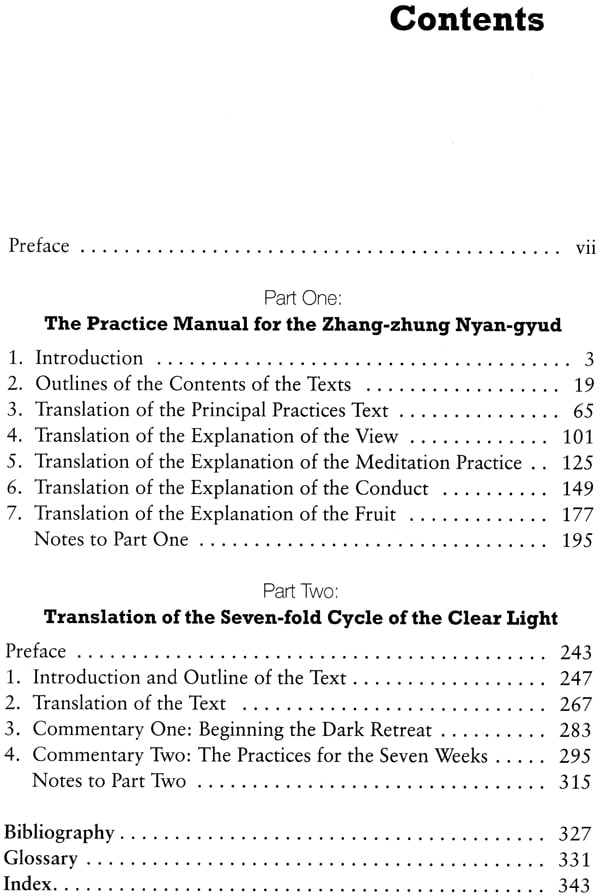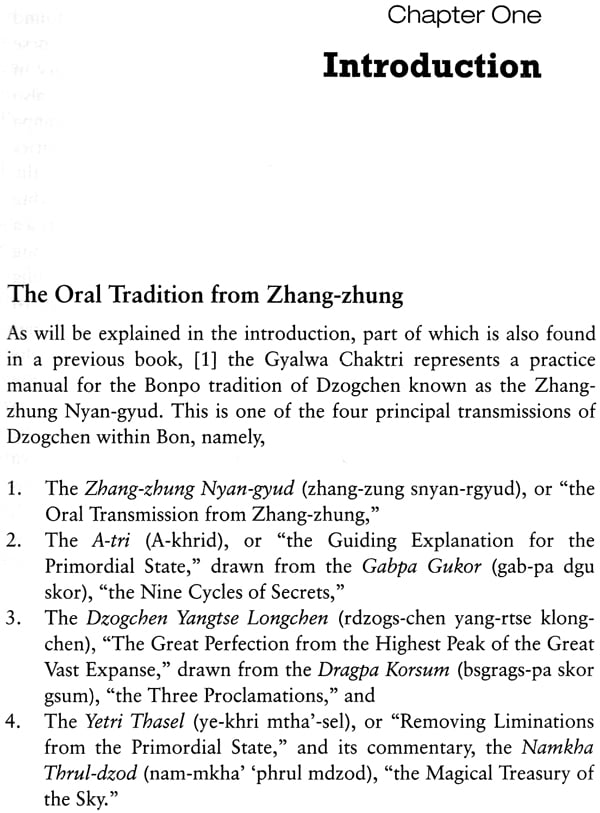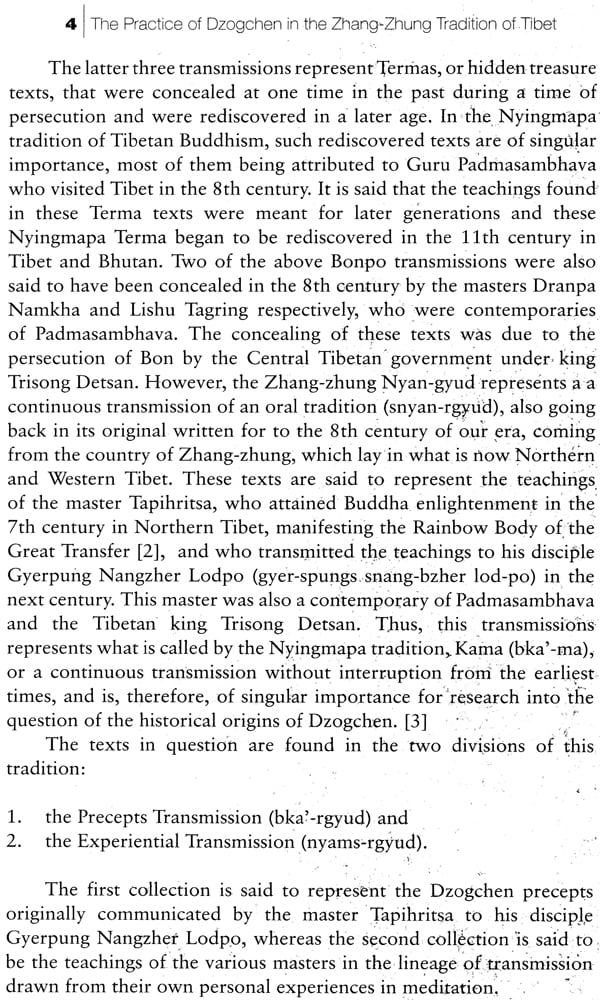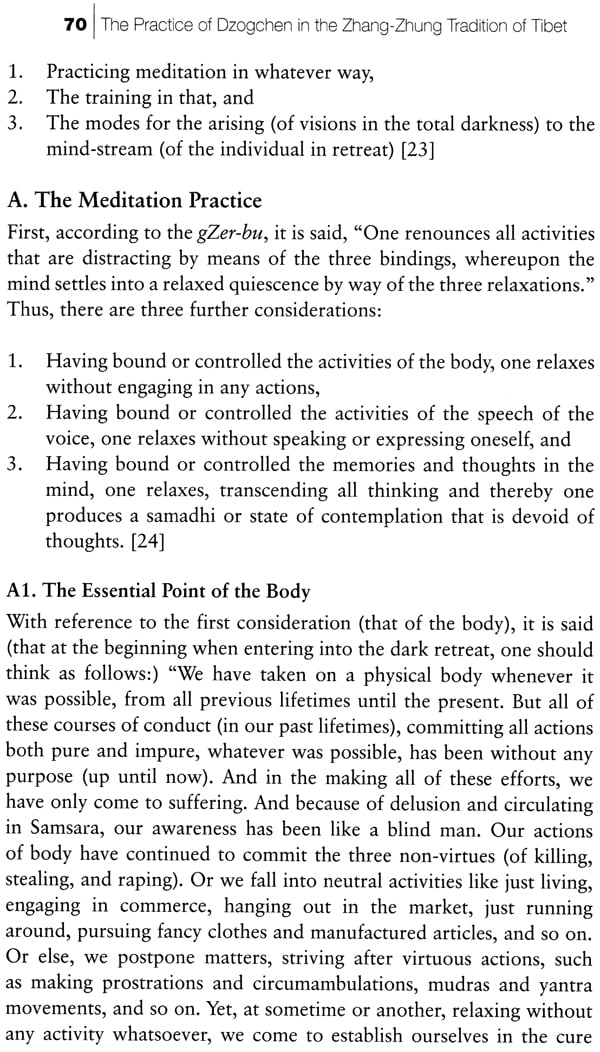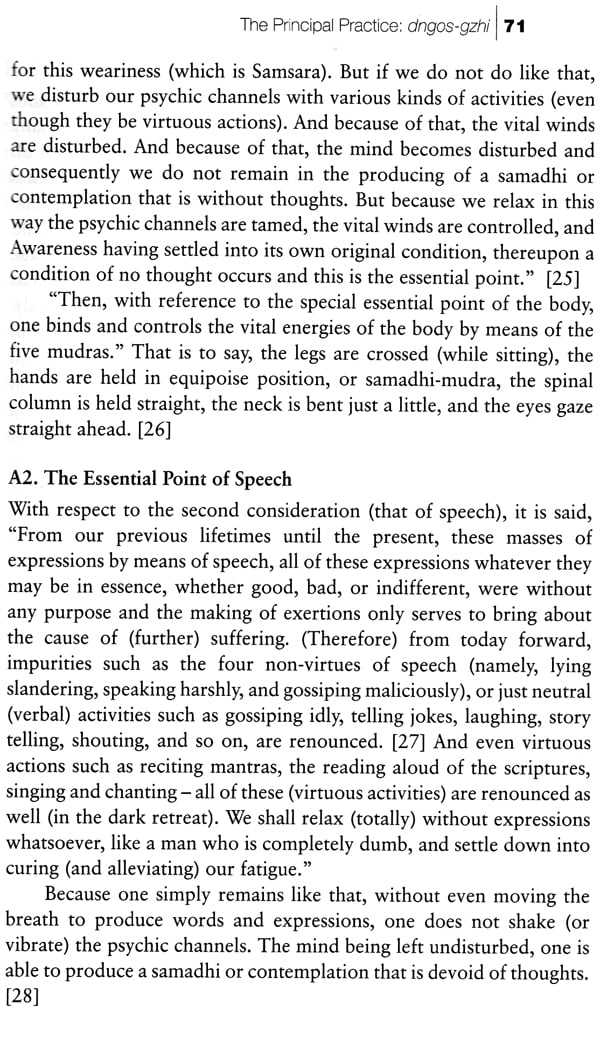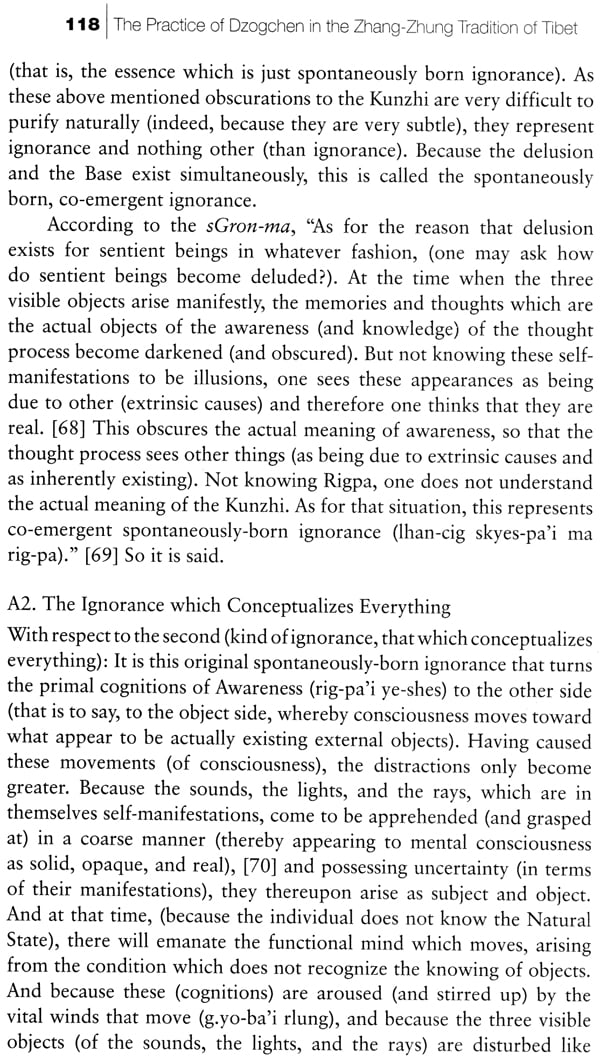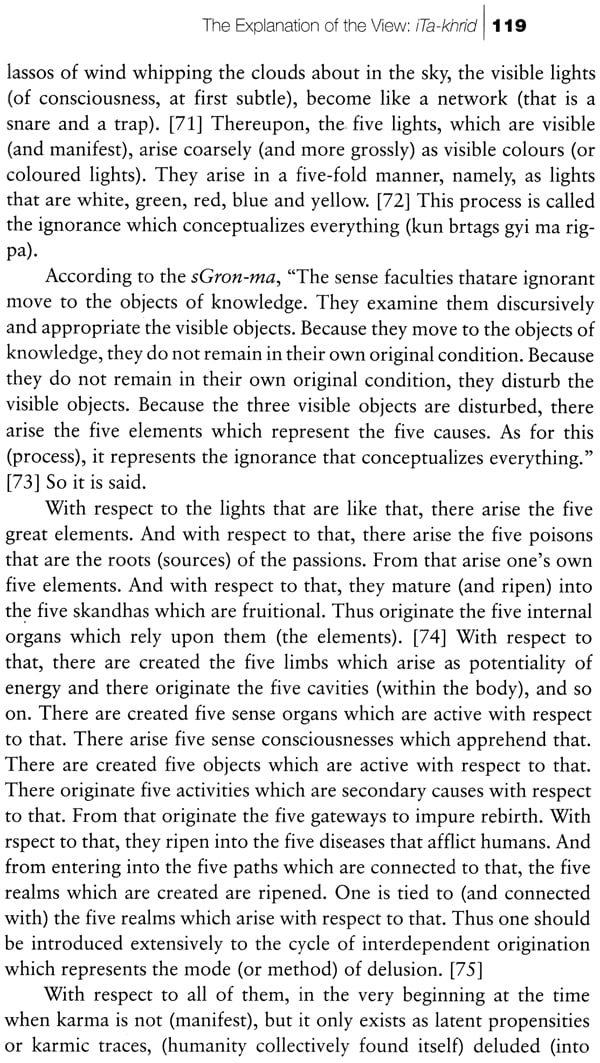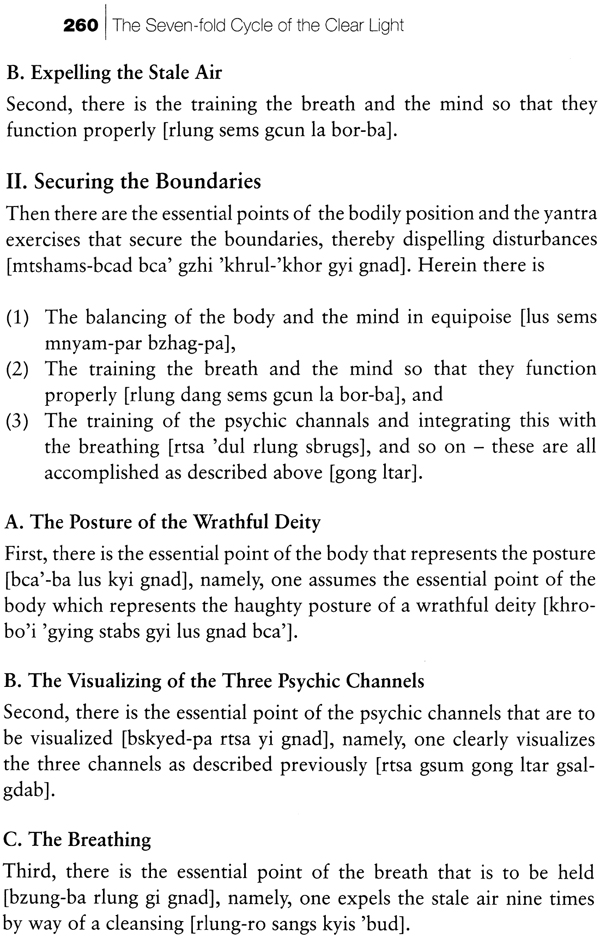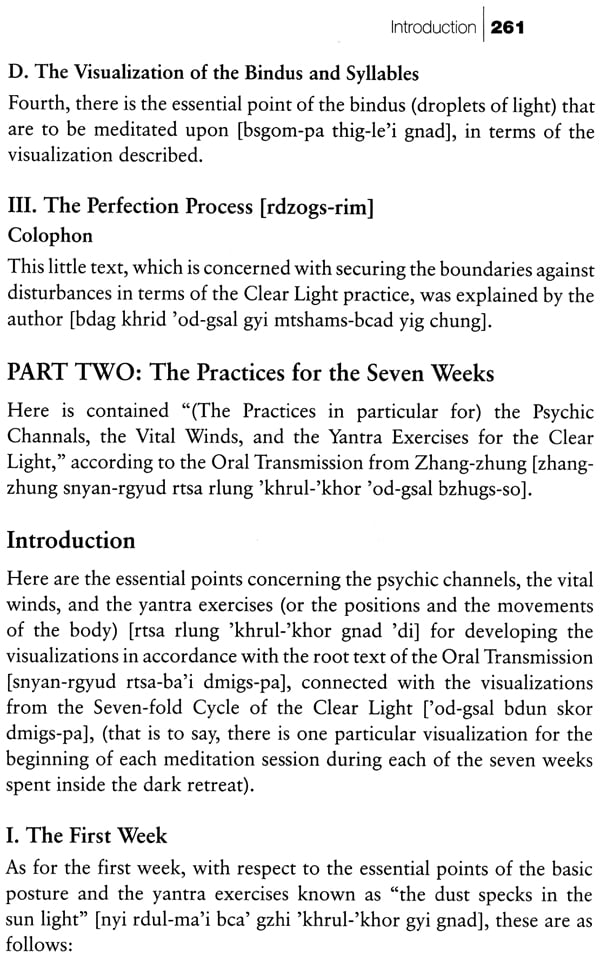
The Practice of Dzogchen in the Zhang-Zhung Tradition of Tibet
Book Specification
| Item Code: | NAS422 |
| Author: | John Myrdhin Reynolds |
| Publisher: | Vajra Books, Nepal |
| Language: | English |
| Edition: | 2015 |
| ISBN: | 9789937506670 |
| Pages: | 356 |
| Cover: | PAPERBACK |
| Other Details | 8.50 X 5.50 inch |
| Weight | 410 gm |
Book Description
The Practice Of Dzogchen In The Zhang-Zhung Tradition Of Tibet, containing translations from the Bonpo Dzogchen practice manual for the Zhang-zhung Nyan-gyud, known as the Gyalwa Chaktri of Druchen Yungdrung, and from the Odsal Dunkor, "The Seven- fold Cycle of the Clear Light,’ being the Dark Retreat practice from the same tradition, translated with commentaries and notes by John Myrdhin Reynolds.
The translations presented here, made by a noted Tibetologist and scholar-practitioner, all relate to the actual practice of Dzogchen, "the Great Perfection," according to the ancient Bonpo tradition of Tibet known as the Zhang-zhung Nyan-gyud, "The Oral Transmission from Zhang-zhung.’ The country of Zhang-zhung was once a powerful kingdom that lay in what is now Western and Northern Tibet, centering around Gangchen Tise, the famous Mount Kailas. As a written tradition, these teachings and practices are said to go back to at least the 8th century of our era, coming from the enlightened Bonpo master Tapihritsa and transmitted to his disciple Gyerpung Nangzher Lodpo at the Darok lake in Northern Tibet. The master Tapihritsa gave his disciple permission to set down in writing these precepts of Dzogchen in the Zhang-zhung language for the first time. Then in the 10th century, these same precepts were translated into the Tibetan language by Ponchen Tsanpo for the benefit of his Tibetan disciples. In the late 11th century, these precepts were collected from various sources in Western Tibet and in Nepal and put into their present form by Orgom Kundul and Yangton Sherab Gyaltsan of Dolpo. Thus, never having | been concealed due persecution, this transmission represents a continuous and uninterrupted lineage from there early times until the present.
In the 13th century, the illustrious Bonpo master and abbot of Yeru Wensakha monastery in Tibet, Druchen Gyalwa Yungdrung (1242-1290), composed a practice manual for the this tradition. Book One deals with the preliminary practices of this Dzogchgen system and the translation this text was published earlier. Included in the present volume are the translations from Book Two that principally deal with the practices of contemplation and vision, otherwise known as Trekchod and Thodgal, as well as translations from Book Three of the four supplementary texts dealing with the view, meditation, conduct, and fruit of Dzogchen. Also included in this volume is a translation of the instructions for making the forty- nine day dark retreat according to the Zhang-zhung tradition, the text known as "The Seven-fold Cycle of the Clear Light,’
These translations were done over a period of time under the guidance and instruction of Yongdzin Rinpoche, Lopon Tenzing Namdak, the greatest living master and native scholar of Dzogchen in the Bonpo tradition. While detailed explanations of the various practices must be had from a qualified Lama belonging to the tradition, this volume provides a useful overview of the practices on the path of Dzogchen for those who are sincerely interested in these matters.
John Myrdhin Reynolds (Vajranatha) is a translator of Tibetan, a scholar in the fields of Tibetan Studies, Buddhist Philosophy, and Comparative Religion, who has taught at a number of universities in the West. He was ordained as a Ngakpa Lama in the Nyingmpa tradition by HH Dudjom Rinpoche, and for more than ten years he has worked closely with Lopen Tenzin Namdak on the translation of early Bonpo Dzogchen and Tantra texts.
His earlier works, The Golden Letters and Self-Liberation, published by Snow Lion, dealt with the origin of Dzogchen in the Nyingmpa Buddhist tradition from India and Central Asia. On The Bonpo tradition of Dzogchen he has published The Oral Tradition from Zhang-Zhung and Bonpo Dzogchen Teachings, both available from Vajra Publications, Kathmandu, Nepal
The translations presented here all relate to the practice of Dzogchen according to the ancient Bonpo tradition of Tibet known as the Zhang- zhung Nyan-gyud, "the Oral Transmission from Zhang-zhung." In a previous volume, The Oral Transmission from Zhang-zhung, I have dealt with the history of the transmission of this lineage of Dzogchen teachings and practices from the remote land of Zhang-zhung, which once lay in what is now Western and Northern Tibet. As a written tradition, these teachings and practices are said to go back at least to the 8th century of our era, coming from the enlightened master Tapihritsa and transmitted to his disciple Gyerpung Nangzher Lodpo, who was given permission to write them down for the first time. This transmission represents a continuous and uninterrupted lineage from that early times to the present. However, the collection known as the Zhang-zhung Nyan-gyud is not set out specifically for practice. Nevertheless, we are fortunate to possess a practice manual or handbook (phyag-khrid) prepared by a 13th century master of the tradition who was also the abbot of Yeru Wensakha monastery (fd. 1072), namely Druchen Gyalwa Yungdrung (1242-1290). This manual, which is named after its author, opens with Book One dealing with the preliminary practices for Dzogchen, which I have translated elsewhere as the Appendix found in The Oral Tradition from Zhang- zhung. Included here in this volume are the translations of Book Two dealing with the practices of Trekchod and Thodgal, and Book Three consisting of four supplementary texts dealing with the view, meditation, conduct, and fruit of Dzogchen. Also included in Part Two of this volume is a translation of the instructions for making a forty- nine day dark retreat according to the Zhang-zhung tradition, a text known as The Seven-fold Cycle of the Clear Light. Although included in the published Tibetan collection, this text was not composed by the above author. In this tradition from Zhang-zhung, the practice of vision, or what is called elsewhere Thodgal, is known here as Clear Light practice (’od-gsal). But in order to enter into the practice of vision, it is first necessary to become stable in the practice of the Natural State (gnas-lugs), or the state of contemplation (mnyam bzhag), which characterised by the presence of Rigpa, or intrinsic awareness. Otherwise, one’s practice will be no better than watching television and the practitioner remains in one’s impure karmic vision. It is with some trepidation that these translations are presented here for publication. One cannot successfully practice the advanced methods of Dzogchen known as the dark retreat, sky meditation, and sunlight practice without the guidance of an accomplished master of Dzogchen. After the initial practice of fixation of the mind on a visible object, or what is generally known as shamatha meditation (zhi-gnas), the practitioner must receive from the master a direct introduction (rig-pa ngo-sprod), where the Natural State of the Nature of Mind is pointed out in one’s immediate experience here and now.
Nevertheless, Yongdzin Lopon Tenzin Namdak, and other Bonpo Lamas have been teaching their tradition for sometime to interested Western practitioners. Thus, there exists a real need for an English translation of the source texts. This is in accordance with the advice given in a vision by the goddess Sidpai Gyalmo, the special guardian to the Bonpo Dzochen tradition, to Lopon Sangye Tenzin (1928-1977) many years ago. The goddess warned that if the teachings and practices of Dzogchen were not made more widely available, the tradition would die out within a generation or two. It was Lopon Sangye Tenzin who was singularly responsible for reviving the teaching and practice of the Zhang-zhung Nyan-gyud tradition at Menri monastery in Tibet, and later in India, whereas at the time the A-tri system of Dzogchen (Akhrid) was largely practiced. Of course, detailed explanations of the practices must be had from a qualified Lama.
These translations were done over a period of time under the guidance and instruction of Yongdzin Lopon Tenzin Namdak (LTN), beginning with the dark retreat text in 1989 during the Lopon’s first visit to America. It is the translator’s hope that these translations will prove useful to serious Western practitioners of the Bonpo Dzogchen tradition that comes from the ancient land of Zhang-zhung.
**Contents and Sample Pages**
